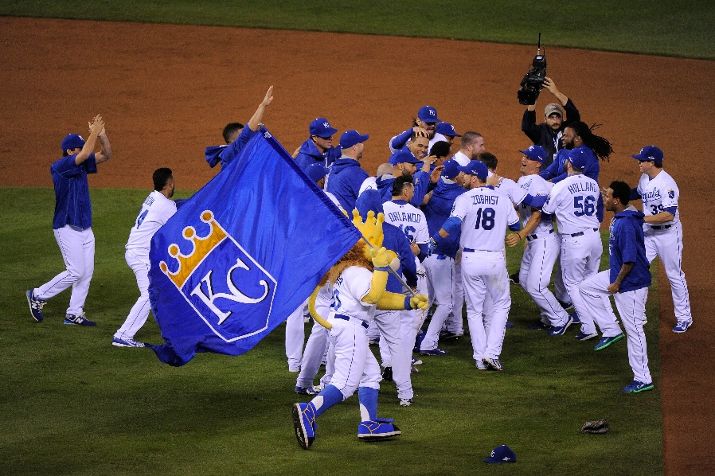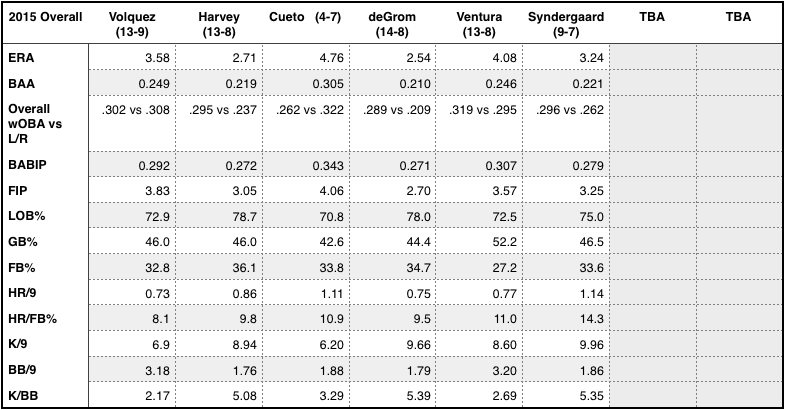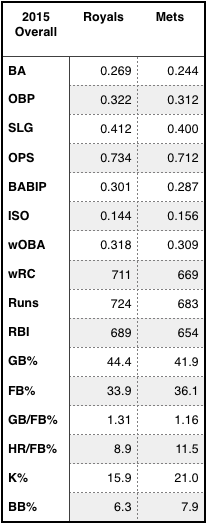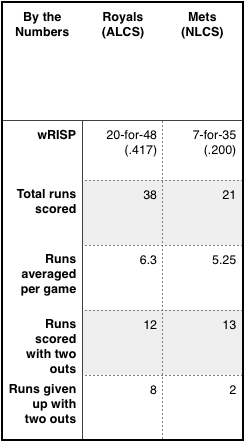
At long last, all of the hard work ― beginning in Spring Training and leading up to now ― comes down to this, the final series of the season. Behold the World Series: the best of seven battle that will be fought between a pair of division champions, the Kansas City Royals and the New York Mets.
Dave Zirin, one of my favorite sports writers, offered a concise summary of the 2015 World Series:
The New York Mets are led by four young, flame-throwing starters whose names are already starting to become local lore: Harvey, DeGrom, Syndergaard, Matz. Each tops 95 miles per hour on the radar gun with little effort and had his National League playoff opponent on the Chicago Cubs swinging at the ghosts of baseballs passed. But the free-swinging Cubs are not the Royals. The Royals are a squad that by a significant margin strikes out less than any team in the Majors. Every at-bat will be part chess match, part blind gamble, where the Royals will dare the young Mets pitchers to throw strikes and the Mets Four Horsemen will throw fat fastballs around the plate and dare the Royals to swing.
Yet there is more to both teams than can be summed up in just one paragraph. For one thing, both squads are rather different from one another. Name any facet of the game, and the Mets and the Royals are on opposite sides of the leaderboard.
On the offensive end of things, the Mets work at-bats and take walks. And though they often slug their way to victory, New York is a pitchable team that tends to strike out at a fair clip. On the other hand, the Royals don’t really do any of that. The emphasis, for Kansas City, is on putting the ball in play ― something that may bode well against the Mets’ high velocity hurlers.
Kansas City feasts on fastballs, and their weighted on base average (wOBA; against the fastball) was 29 points better than the league’s. Against 94-96 mph fastball, that gap grew to 51 points. Even at 96 mph and above, the Royals were still significantly better than they were against all pitches. The Mets, however, posted only a .272 wOBA on fastballs, and unfortunately for them, Kansas City’s staff ― led by Yordano Ventura ― throws almost as hard as New York’s staff.
Their ability to hit the fastball poses a problem for the Mets, a team that relies more heavily on the heater than any other 2015 playoff team.
Although to be fair, New York hasn’t slouched in the offseason, plating 43 runs in its nine games for an average of just under five runs per game. Daniel Murphy, who has powered the Mets’ offense, has homered in six consecutive playoff games (postseason record), and enters the World Series slashing .421/.436/1.026 with 11 runs scored and 11 RBI. Overall, New York has scored in the first inning in each of their last five games. The Mets haven’t trailed since Game 5 of the NLDS against the Los Angeles Dodgers.
Defensively speaking, the Royals are far superior. Kansas City boasts a roster composed of rangy athletes, while New York is average at best. As it relates to defensive value for the season (as measured by FanGraphs), the Royals are number one and the Mets are 17th. On top of that, the Royals are second only to the Arizona Diamondbacks with 56 defensive runs saved. The Mets? They rank 21st with a -7 DRS.
Eno Sarris (FanGraphs) also noted another stark difference between each club:
…once you separate plays into easy and hard bins. Easy plays, sure, the Mets can get the ball to the base or squeeze the glove like the rest of them. They’re 16th on plays that are made 60-100% of the time by Inside Edge, and the Royals are 12th. If you hit it right at them, there’s not that much of a difference here.
If you hit it a little further away, though, the Royals’ defense really separates itself. They can pick it. Now the Royals are second and the Mets are 25th.
Another narrative will surely dominate the series: The Mets’ starting rotation vs. the Royals’ bullpen. The skinny, New York’s foursome of twenty-somethings has led a staff that’s collected a 2.81 ERA in the postseason, with 91 strikeouts and just 22 walks in nine games. The Royals ‘pen is composed of hurlers strong enough to help prop up the rest of the team, especially when the starters don’t go deep.
Terry Collins will throw Matt Harvey, Jacob deGrom, and Noah Syndergaard in the front three games of the series. Ned Yost will counter with Edinson Volquez, Johnny Cueto, and Yordano Ventura. The announcement of who will pitch and when from game four on is expected shortly.



Edinson Volquez (1-2, 4.32 ERA in the postseason) tossed six innings of two-hit, shutout ball en route to grabbing the win in the opening game of the ALCS. Volquez didn’t fare as well in his Game 5 start, however, allowing five runs over five innings. Key matchups: Yoenis Cespedes (1-3), Michael Cuddyer (4-11, 2 RBI, 3 BB), Lucas Duda (2-8, 2B, 3 BB), Wilmer Flores (1-3, 2B), Kelly Johnson (4-14, 2B, 2 RBI, 3 BB), Daniel Murphy (6-15, 2B, 2 RBI, 3 BB)
Matt Harvey (2-0, 2.84 ERA in the postseason) will take the mound in game on. He may also take the hill in Game 5 and could be available out of the bullpen for a deciding Game 7. In two starts (both wins) this postseason, he’s allowed five runs (four earned) on 11 hits and four walks while striking out 16 in 12-2/3 innings. Key matchup: Alex Rios (1-3)
Johnny Cueto (1-1, 7.88 ERA in the postseason) has proved to be inconsistent in the postseason. He followed up his great Game 5 performance in the ALDS by allowing eight runs over just two innings in his lone start against the Blue Jays. Key matchups: Travis d’Arnaud (3-5, 2 2B, BB), Curtis Granderson (2 HR, 3 RBI, 4 BB), Juan Uribe (2-6, 2B, 2 RBI)
Jacob deGrom (3-0, 1.80 ERA in the postseason) has given up four runs on 15 hits and five walks while punching out 27 in 20 postseason innings. He is also expected to take the mound in Game 6.
Yordano Ventura (0-1, 5.09 ERA in the postseason) was given the start in the ALCS-clinching Game 6, going 5-1/3 innings while allowing just one run. The righty went through some rough patches in the regular season, but he’s been able to hold opponents to three or fewer runs in all four postseason starts.
Noah Syndergaard (1-1, 2.77 ERA in the postseason) will be the third starter in the Mets’ four-man rotation. As a result, Syndergaard may take the hill in Game 7, if needed. In three appearances (two starts) this postseason, he’s posted a 1-1 record, while surrendering just four runs on eight hits and six walks while fanning 20 in 13 innings.
Noteworthiness
― This being a living/breathing document, expect some edits and additions over the course of the series. That is, keep checking back!
